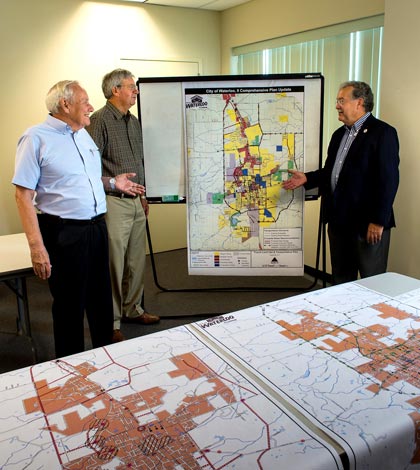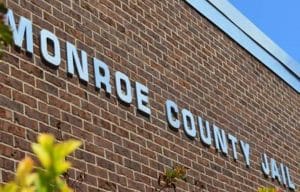Group discusses four-lane highway to Murphysboro

Pictured, from left, representatives from Monroe, Perry and Randolph counties — Bob Elmore, Jim Epplin and Mark Kiehna — survey maps of the area that would be affected by a new four-lane highway from Waterloo to Murphysboro. (Alan Dooley photo)
Representatives of three of the four counties impacted by possible plans to expand a highway route from Waterloo to Murphysboro met last Tuesday in Waterloo.
The proposed highway would connect to the Route 3 bypass in Waterloo, and proceed to Murphysboro, following a still-to-be-determined route past Red Bud and Sparta to Pinckneyville and Murphysboro.
“This is a marathon, not a sprint,” said Randolph County Commissioner Mark Kiehna, who is leading the group.
Thirty-three people attended the morning session — the first of many. It was held at the Monroe County Courthouse.
“These sessions are intended to be totally transparent,” Kiehna said. “There are no hidden agendas involved. We want inputs, pro or con.”
The project that would extend regional four-lane connectivity through southern Illinois from St. Louis to Murphysboro has been kicked around for 30 years or more, Kiehna said.
He swiftly ticked off a list of groups that have weighed in supporting the idea since the four-county group was formed earlier this year.
“All four counties are on board, with numerous communities, as well as the Kaskaskia Regional Port District, farm bureaus, numerous businesses and labor unions,” Kiehna said, adding Waterloo Mayor Tom Smith, host of this meeting, reported the city of Waterloo is climbing aboard as well.
The plan has received especially strong endorsement from Southern Illinois University at Carbondale. The school notes in its letter of support that the region is home to its 8,000 employees, 12,000 students and an alumni body of more than 80,000 who visit frequently to attend events and programs.
Monroe County’s representative on the group, Monroe County Board Chairman Bob Elmore, noted that while there are many economically strong areas along the route, there are also areas of significant poverty issues. “Poverty’s not just about Chicago,” he added.
Perry County’s representative to the group, County Commissioner Jim Epplin, echoed Elmore’s evaluation and the opinion that this project — like a marathon — has a long way to go.
In fact, the project is really just a plan at this stage. No engineering designs have been made, and the route is not even certain at this juncture. The segment between Murphysboro and Pinckneyville is the only section that is even in the state’s long range plans. That segment alone is projected to cost $212 million — and there is no funding currently in sight.
One attendee pointed out another costly project in the same region. The heavily used 75-year-old Chester bridge over the Mississippi River is deteriorating from age and overuse, and is a potential candidate for federal funding.
Kiehna addressed such a highway’s potential effects on the predominant economic engine of the region — farming.
“We absolutely must be mindful of how this would impact farmers,” he said. “Would such a highway help or hinder them?” he asked.
One farmer present noted that when the bypass around Waterloo was being designed, IDOT wanted to include curbing. Farm interests convinced them of the necessity of wide, flat shoulders to accommodate farm machinery.
Another attendee added that while much of the proposed route follows existing highways, newly constructed by-passes around communities would follow routes through existing farmland.
Farm concerns were also on Elmore’s mind when he said “98 percent of the route is through farm land. Farmers are justifiably concerned — would this take their land for someone else’s benefit? We have to be mindful of their concerns and their benefits.”
Another farm interest that arose when the Waterloo by-pass was designed was the width of the medians as they were originally planned.
“We need to be able to safely cross a four-lane highway with a grain truck or farm machine,” an attendee said. “Neither are cars and they don’t accelerate like them.”
“We will need a lot of collaboration between potentially disparate groups,” Kiehna acknowledged, emphasizing again, “We must be transparent in our discussions.”
One interested citizen even noted that no fewer than six Native American tribes may have input that would have to be taken into account.
Local farmer and former Monroe County commissioner Terry Liefer opined that it may be time for the group to start seeking out seed money to add impact to its planning efforts.
He also noted the stretch of Route 3 from Waterloo to Red Bud currently qualifies for additional lanes, as it carries 11,000 vehicles daily.
“I drive it daily,” he said, “and parts of it are frankly not safe.”
Mayor Smith addressed the subject of the impacts of bypasses on individual communities. He and former Waterloo alderman, Vickie Koerber, who is now a Monroe County commissioner, both said Waterloo played a significant role in planning the bypass. The city sought a number of grants, including one to renovate the façades on many of the old buildings in town. Some of these grants have improved downtown as a whole, making it a vibrant and busy retail and dining destination.
“In fact, some nights of the week it’s hard to find parking downtown,” Koerber said. “That’s a good problem to have,” she added.
Another attendee emphasized why project planning and discussions must be inclusive and transparent. He provided the example of a plan to build a bypass from I-255 around Columbia to Belleville that failed because the concerns of land owners were not sufficiently addressed.
“In the end, businesses endorsed the plan, but home and farm owners’ interests were not adequately addressed. It became too much trouble and the plan died,” he said
One citizen asked a question that has been on many people’s minds. “What are we doing for the kids — the ones who grow up here, go away to get educations and don’t come back because there are no jobs? This is what we are doing,” he emphasized. “Better transportation will lead to businesses, which means jobs, which means young people can stay here.”
Monroe County Economic Development Corporation Director Edie Koch explained that four-lane highways are critical to new business development, which needs economical, efficient ways to get and send products and services.
“Businesses looking at a piece of property will often ask, ‘How far is it from a four-lane highway?’” she said.
Liefer proposed breaking the project down into manageable parts and attacking one at a time.
“Build what gets funded first, and then work to connect those segments,” he said.
Liefer also noted the four counties — Monroe, Randolph, Perry and Jackson — are stronger together than apart.
“Three counties came together to attack the issue of restoring flood protection to the bottoms along the Mississippi,” he said. “Together, we are getting it done cheaper and maybe 25 years ahead of the federal government’s proposal.”
Kiehna said the group is slated to meet with Congressman Mike Bost (R-Murphysboro) to try to drive inclusion of this idea in federal infrastructure planning.
“He’s told us that showing local interest and support is how to get it on the table. We intend to do just that,” Kiehna concluded.






